CHRYSLER CROSSFIRE 2008 1.G Owners Manual
Manufacturer: CHRYSLER, Model Year: 2008, Model line: CROSSFIRE, Model: CHRYSLER CROSSFIRE 2008 1.GPages: 358, PDF Size: 4.7 MB
Page 161 of 358
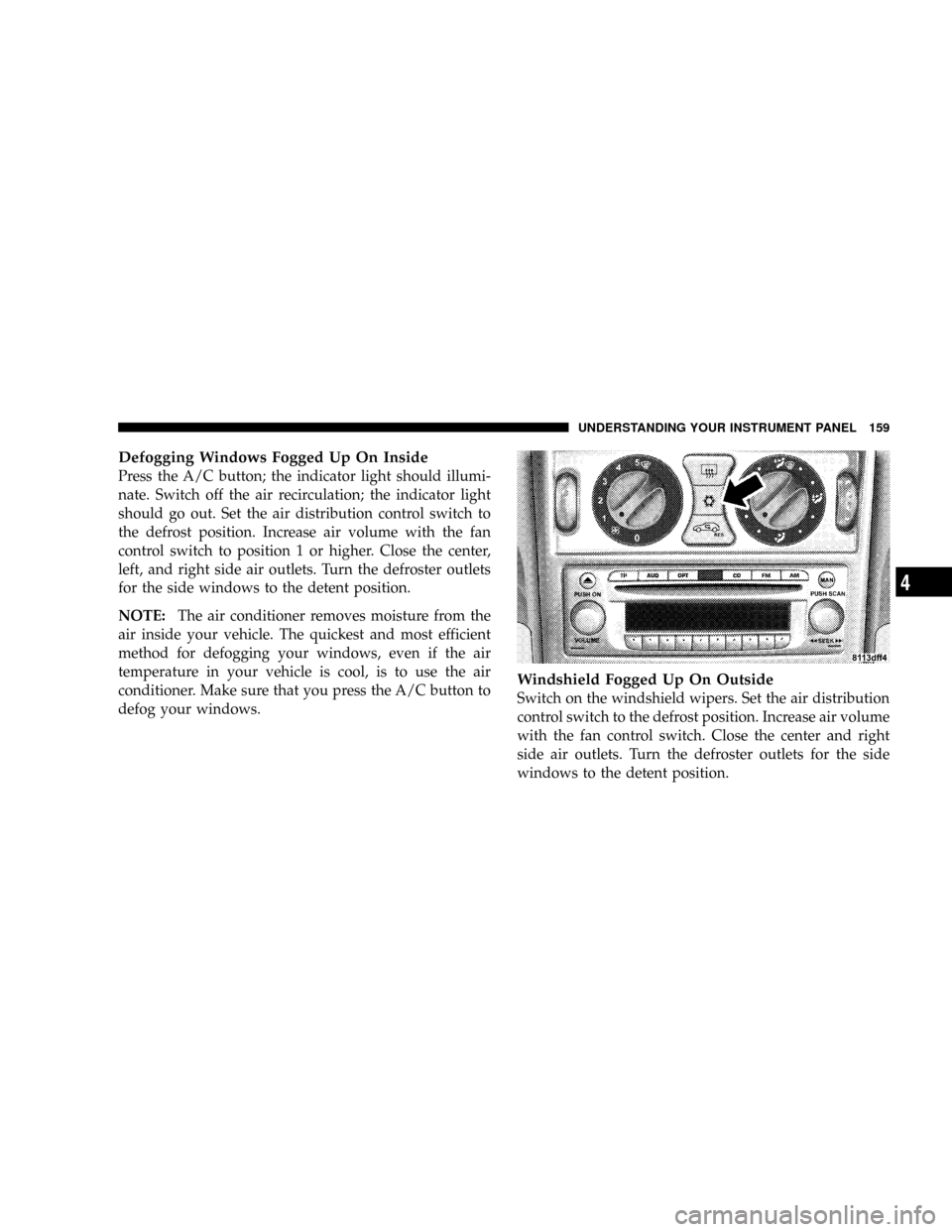
Defogging Windows Fogged Up On Inside
Press the A/C button; the indicator light should illumi-
nate. Switch off the air recirculation; the indicator light
should go out. Set the air distribution control switch to
the defrost position. Increase air volume with the fan
control switch to position 1 or higher. Close the center,
left, and right side air outlets. Turn the defroster outlets
for the side windows to the detent position.
NOTE:The air conditioner removes moisture from the
air inside your vehicle. The quickest and most efficient
method for defogging your windows, even if the air
temperature in your vehicle is cool, is to use the air
conditioner. Make sure that you press the A/C button to
defog your windows.
Windshield Fogged Up On Outside
Switch on the windshield wipers. Set the air distribution
control switch to the defrost position. Increase air volume
with the fan control switch. Close the center and right
side air outlets. Turn the defroster outlets for the side
windows to the detent position.
UNDERSTANDING YOUR INSTRUMENT PANEL 159
4
Page 162 of 358
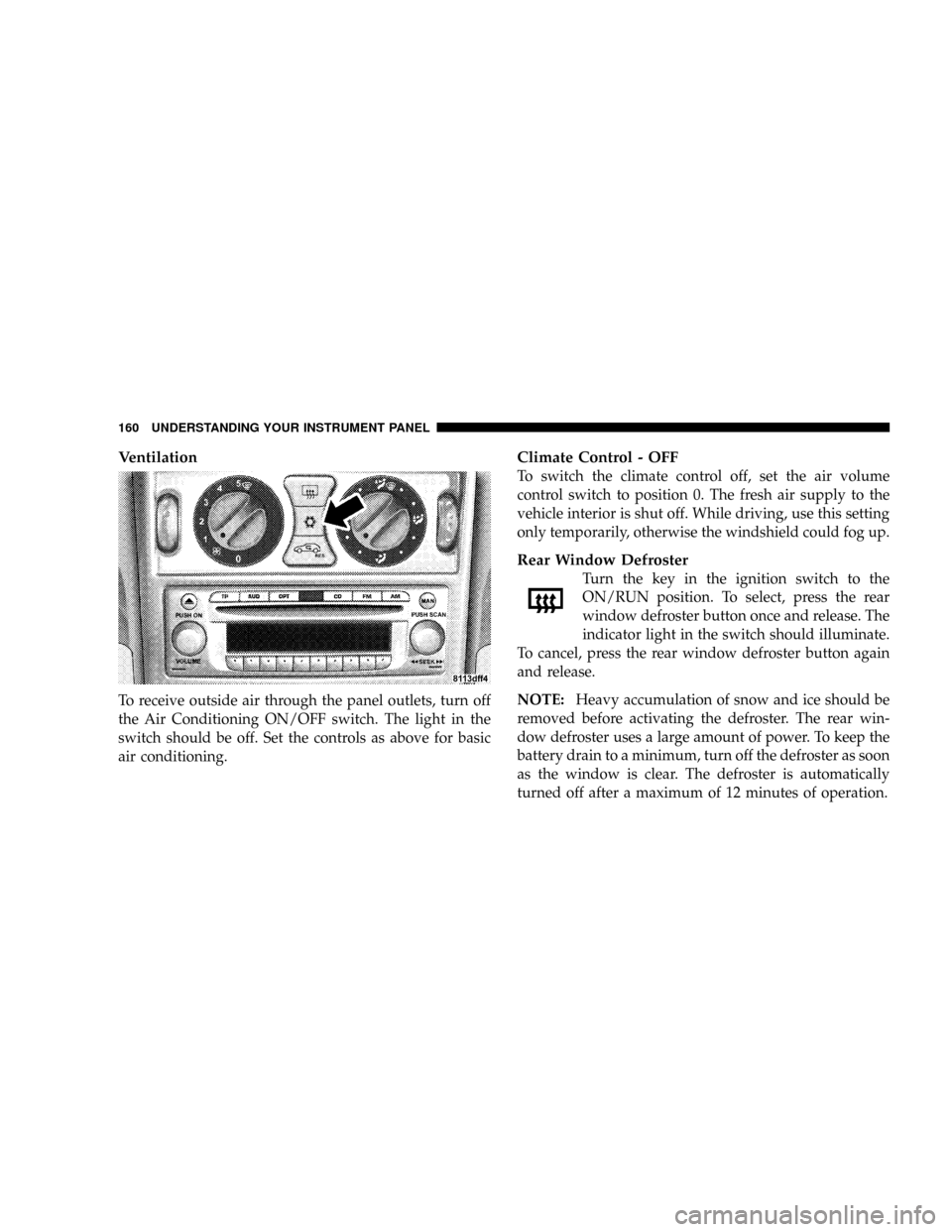
Ventilation
To receive outside air through the panel outlets, turn off
the Air Conditioning ON/OFF switch. The light in the
switch should be off. Set the controls as above for basic
air conditioning.
Climate Control - OFF
To switch the climate control off, set the air volume
control switch to position 0. The fresh air supply to the
vehicle interior is shut off. While driving, use this setting
only temporarily, otherwise the windshield could fog up.
Rear Window Defroster
Turn the key in the ignition switch to the
ON/RUN position. To select, press the rear
window defroster button once and release. The
indicator light in the switch should illuminate.
To cancel, press the rear window defroster button again
and release.
NOTE:Heavy accumulation of snow and ice should be
removed before activating the defroster. The rear win-
dow defroster uses a large amount of power. To keep the
battery drain to a minimum, turn off the defroster as soon
as the window is clear. The defroster is automatically
turned off after a maximum of 12 minutes of operation.
160 UNDERSTANDING YOUR INSTRUMENT PANEL
Page 163 of 358
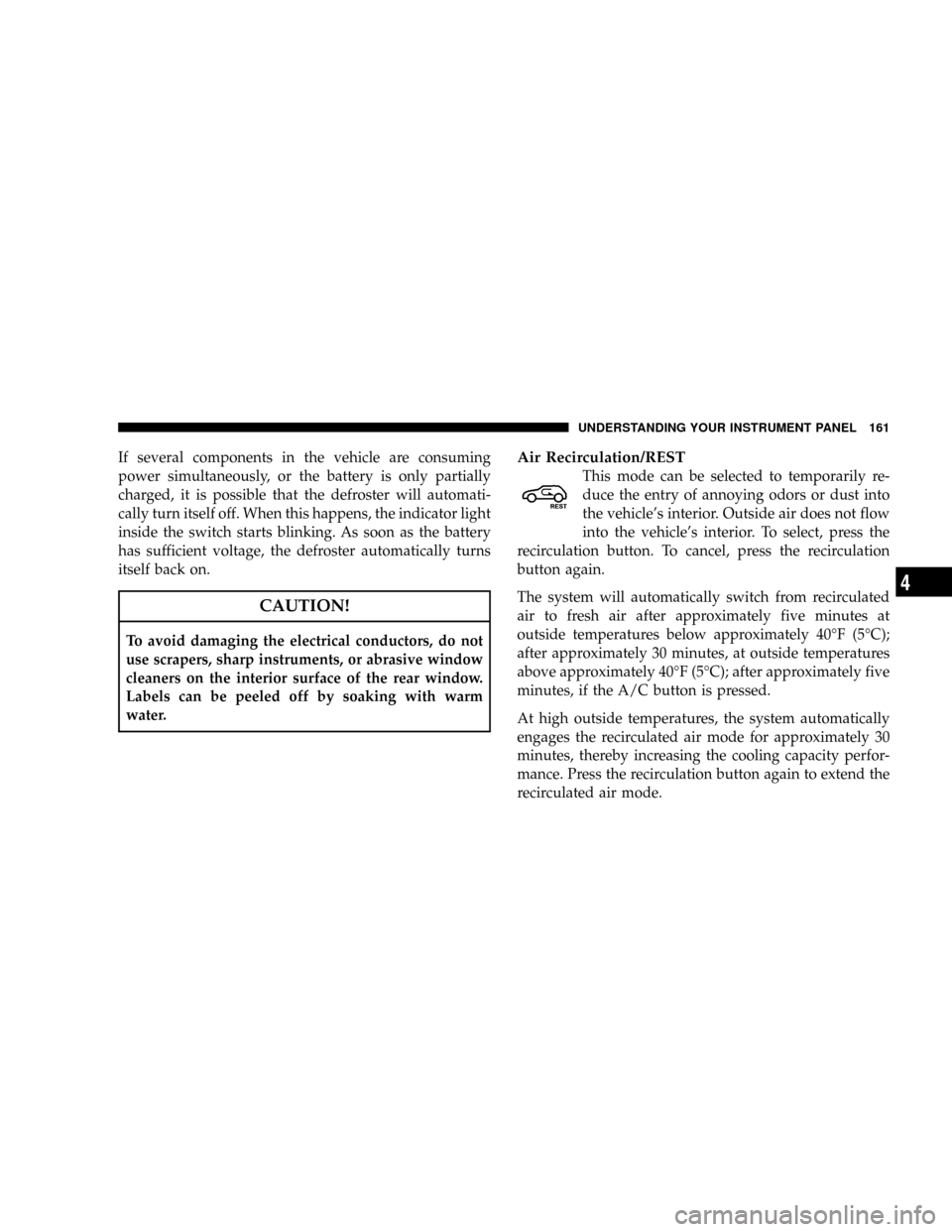
If several components in the vehicle are consuming
power simultaneously, or the battery is only partially
charged, it is possible that the defroster will automati-
cally turn itself off. When this happens, the indicator light
inside the switch starts blinking. As soon as the battery
has sufficient voltage, the defroster automatically turns
itself back on.
CAUTION!
To avoid damaging the electrical conductors, do not
use scrapers, sharp instruments, or abrasive window
cleaners on the interior surface of the rear window.
Labels can be peeled off by soaking with warm
water.
Air Recirculation/REST
This mode can be selected to temporarily re-
duce the entry of annoying odors or dust into
the vehicle's interior. Outside air does not flow
into the vehicle's interior. To select, press the
recirculation button. To cancel, press the recirculation
button again.
The system will automatically switch from recirculated
air to fresh air after approximately five minutes at
outside temperatures below approximately 40ÉF (5ÉC);
after approximately 30 minutes, at outside temperatures
above approximately 40ÉF (5ÉC); after approximately five
minutes, if the A/C button is pressed.
At high outside temperatures, the system automatically
engages the recirculated air mode for approximately 30
minutes, thereby increasing the cooling capacity perfor-
mance. Press the recirculation button again to extend the
recirculated air mode.
UNDERSTANDING YOUR INSTRUMENT PANEL 161
4
Page 164 of 358
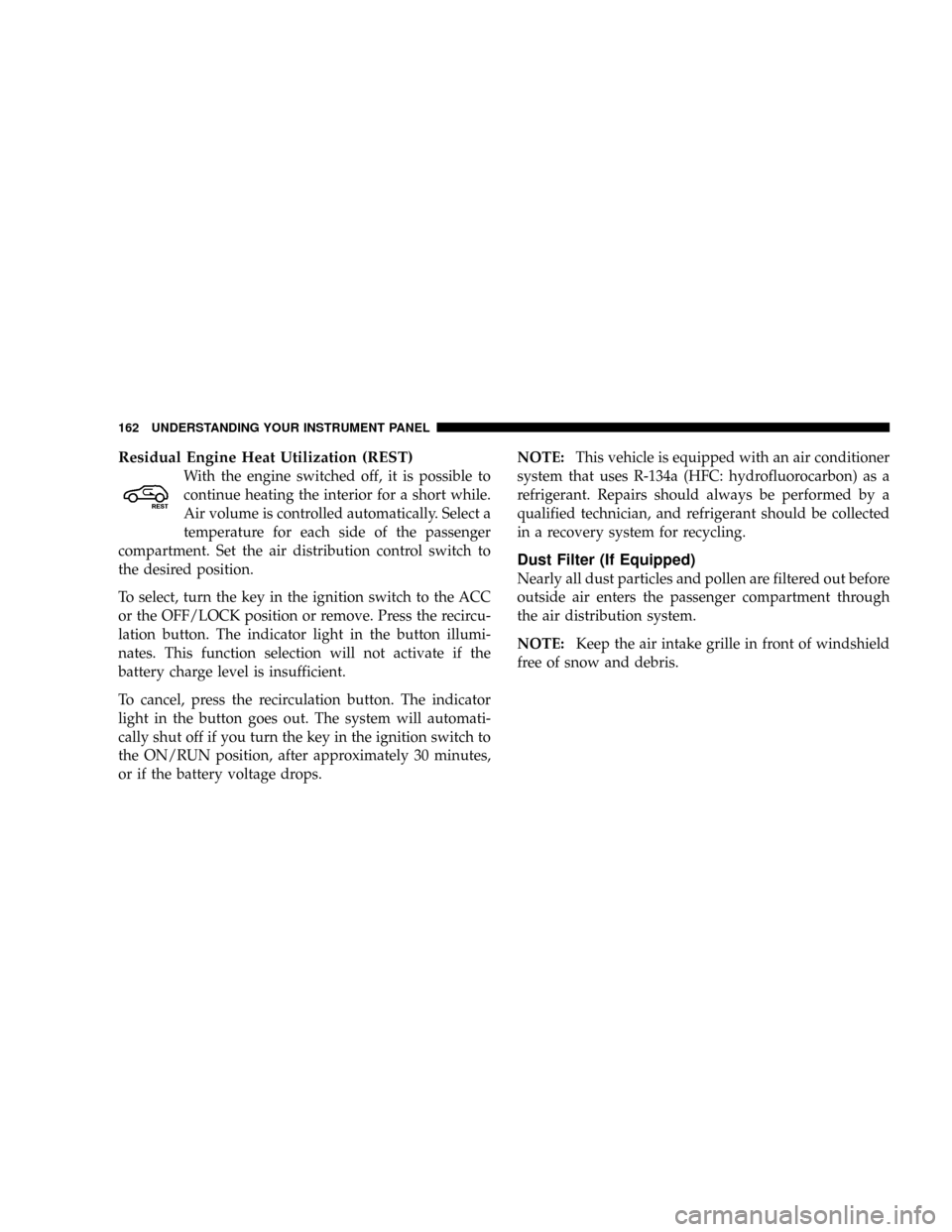
Residual Engine Heat Utilization (REST)
With the engine switched off, it is possible to
continue heating the interior for a short while.
Air volume is controlled automatically. Select a
temperature for each side of the passenger
compartment. Set the air distribution control switch to
the desired position.
To select, turn the key in the ignition switch to the ACC
or the OFF/LOCK position or remove. Press the recircu-
lation button. The indicator light in the button illumi-
nates. This function selection will not activate if the
battery charge level is insufficient.
To cancel, press the recirculation button. The indicator
light in the button goes out. The system will automati-
cally shut off if you turn the key in the ignition switch to
the ON/RUN position, after approximately 30 minutes,
or if the battery voltage drops.NOTE:This vehicle is equipped with an air conditioner
system that uses R-134a (HFC: hydrofluorocarbon) as a
refrigerant. Repairs should always be performed by a
qualified technician, and refrigerant should be collected
in a recovery system for recycling.
Dust Filter (If Equipped)
Nearly all dust particles and pollen are filtered out before
outside air enters the passenger compartment through
the air distribution system.
NOTE:Keep the air intake grille in front of windshield
free of snow and debris.
162 UNDERSTANDING YOUR INSTRUMENT PANEL
Page 165 of 358
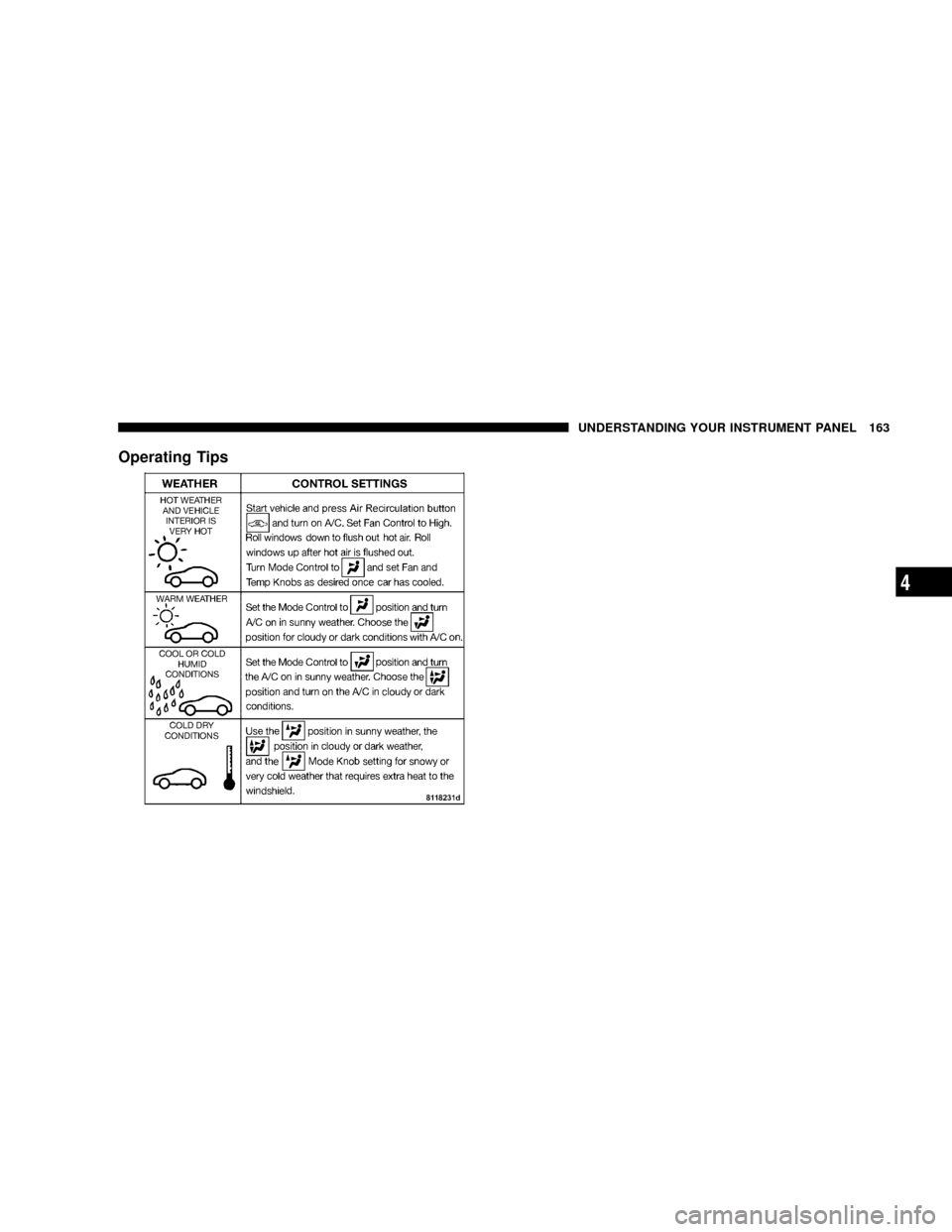
Operating Tips
UNDERSTANDING YOUR INSTRUMENT PANEL 163
4
Page 166 of 358

Page 167 of 358
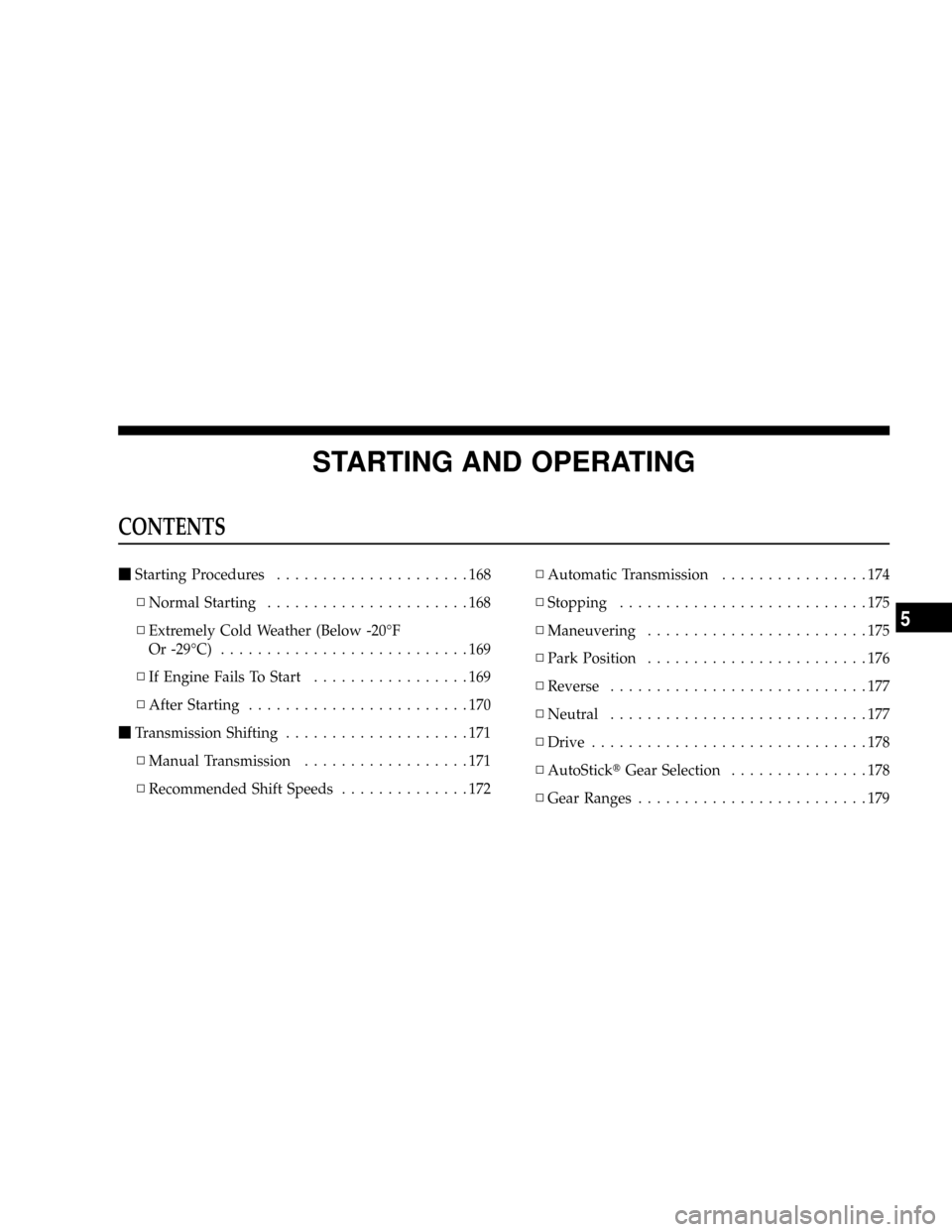
STARTING AND OPERATING
CONTENTS
mStarting Procedures.....................168
NNormal Starting......................168
NExtremely Cold Weather (Below -20ÉF
Or -29ÉC)...........................169
NIf Engine Fails To Start.................169
NAfter Starting........................170
mTransmission Shifting....................171
NManual Transmission..................171
NRecommended Shift Speeds..............172NAutomatic Transmission................174
NStopping...........................175
NManeuvering........................175
NPark Position........................176
NReverse............................177
NNeutral............................177
NDrive..............................178
NAutoSticktGear Selection...............178
NGear Ranges.........................179
5
Page 168 of 358
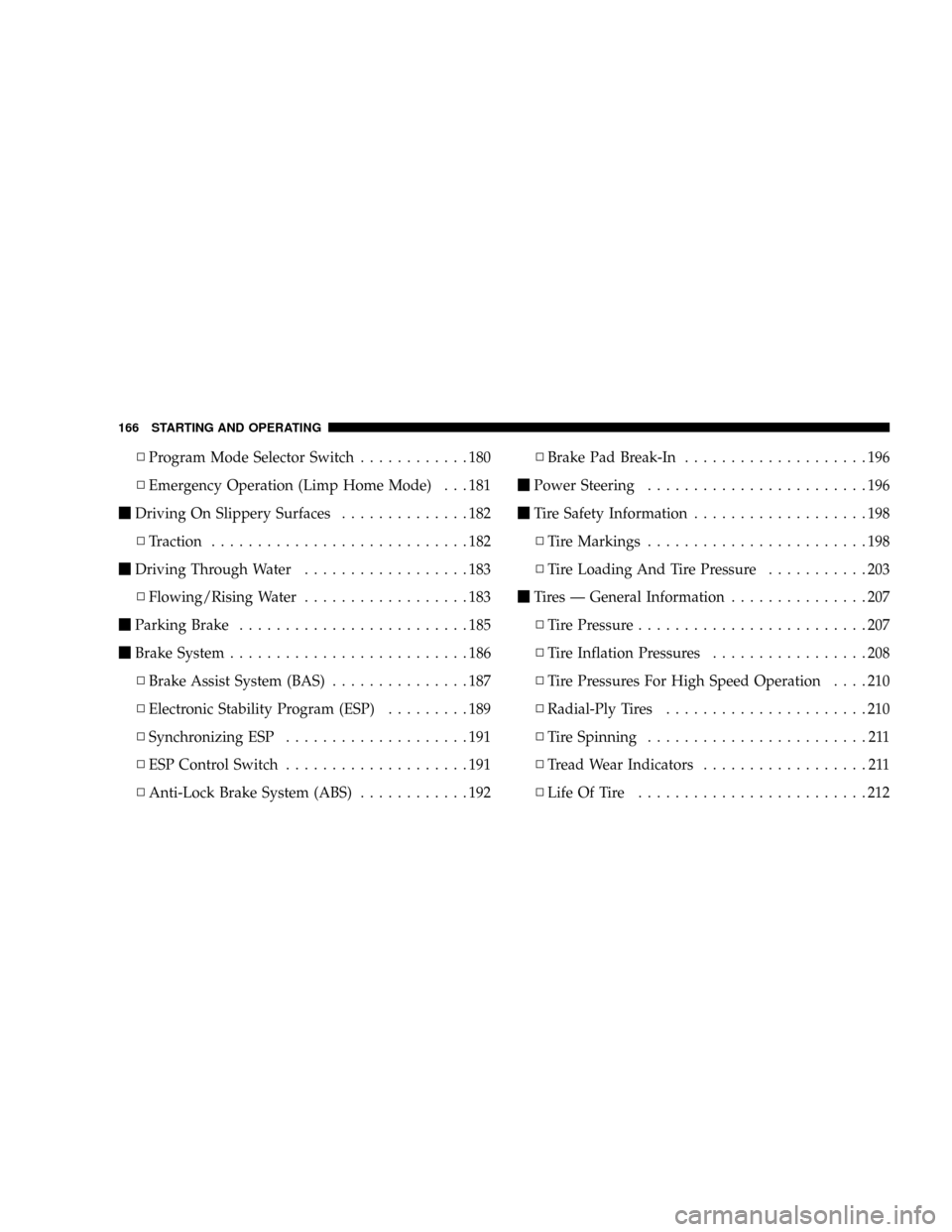
NProgram Mode Selector Switch............180
NEmergency Operation (Limp Home Mode) . . . 181
mDriving On Slippery Surfaces..............182
NTraction............................182
mDriving Through Water..................183
NFlowing/Rising Water..................183
mParking Brake.........................185
mBrake System..........................186
NBrake Assist System (BAS)...............187
NElectronic Stability Program (ESP).........189
NSynchronizing ESP....................191
NESP Control Switch....................191
NAnti-Lock Brake System (ABS)............192NBrake Pad Break-In....................196
mPower Steering........................196
mTire Safety Information...................198
NTire Markings........................198
NTire Loading And Tire Pressure...........203
mTires Ð General Information...............207
NTire Pressure.........................207
NTire Inflation Pressures.................208
NTire Pressures For High Speed Operation....210
NRadial-Ply Tires......................210
NTire Spinning........................211
NTread Wear Indicators..................211
NLife Of Tire.........................212
166 STARTING AND OPERATING
Page 169 of 358
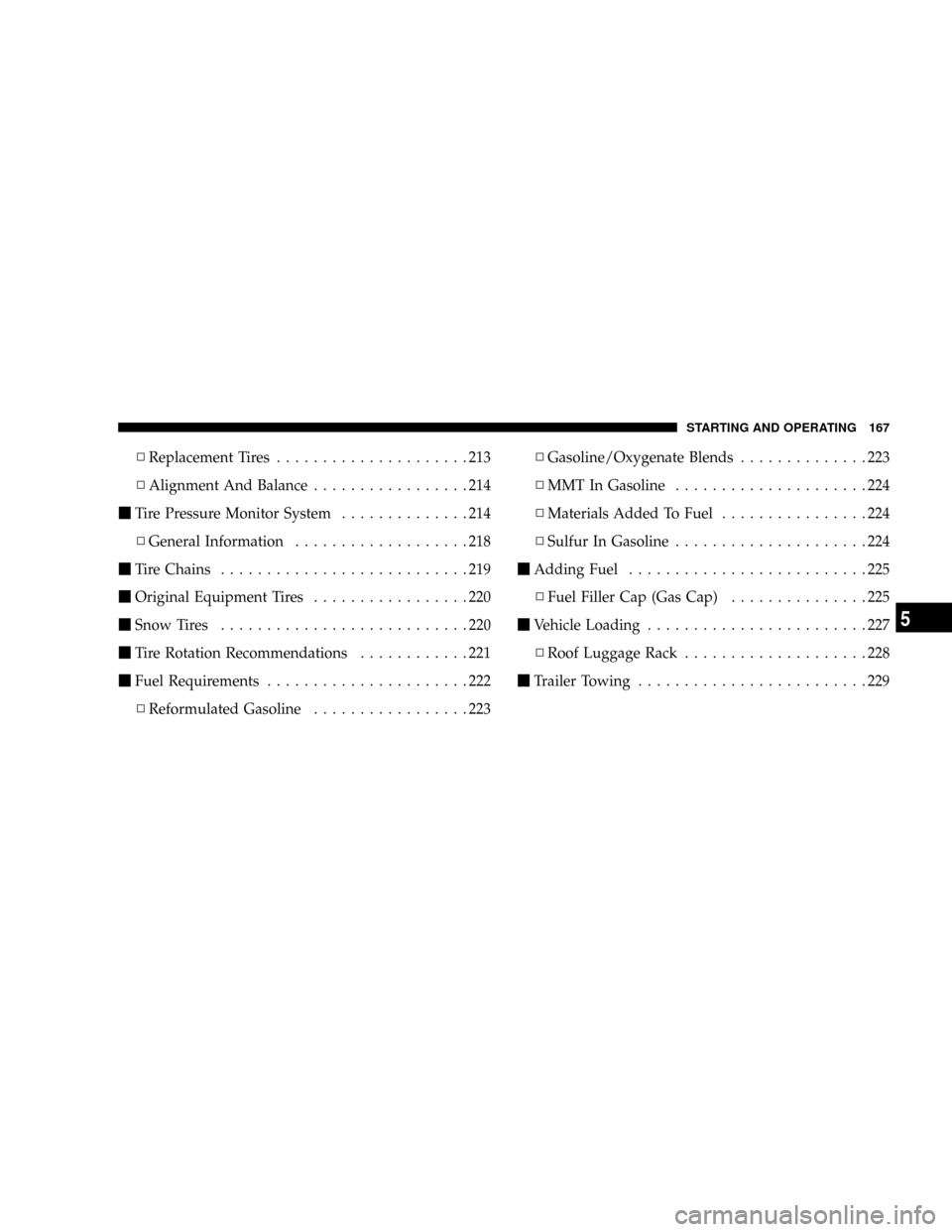
NReplacement Tires.....................213
NAlignment And Balance.................214
mTire Pressure Monitor System..............214
NGeneral Information...................218
mTire Chains...........................219
mOriginal Equipment Tires.................220
mSnow Tires...........................220
mTire Rotation Recommendations............221
mFuel Requirements......................222
NReformulated Gasoline.................223NGasoline/Oxygenate Blends..............223
NMMT In Gasoline.....................224
NMaterials Added To Fuel................224
NSulfur In Gasoline.....................224
mAdding Fuel..........................225
NFuel Filler Cap (Gas Cap)...............225
mVehicle Loading........................227
NRoof Luggage Rack....................228
mTrailer Towing.........................229
STARTING AND OPERATING 167
5
Page 170 of 358
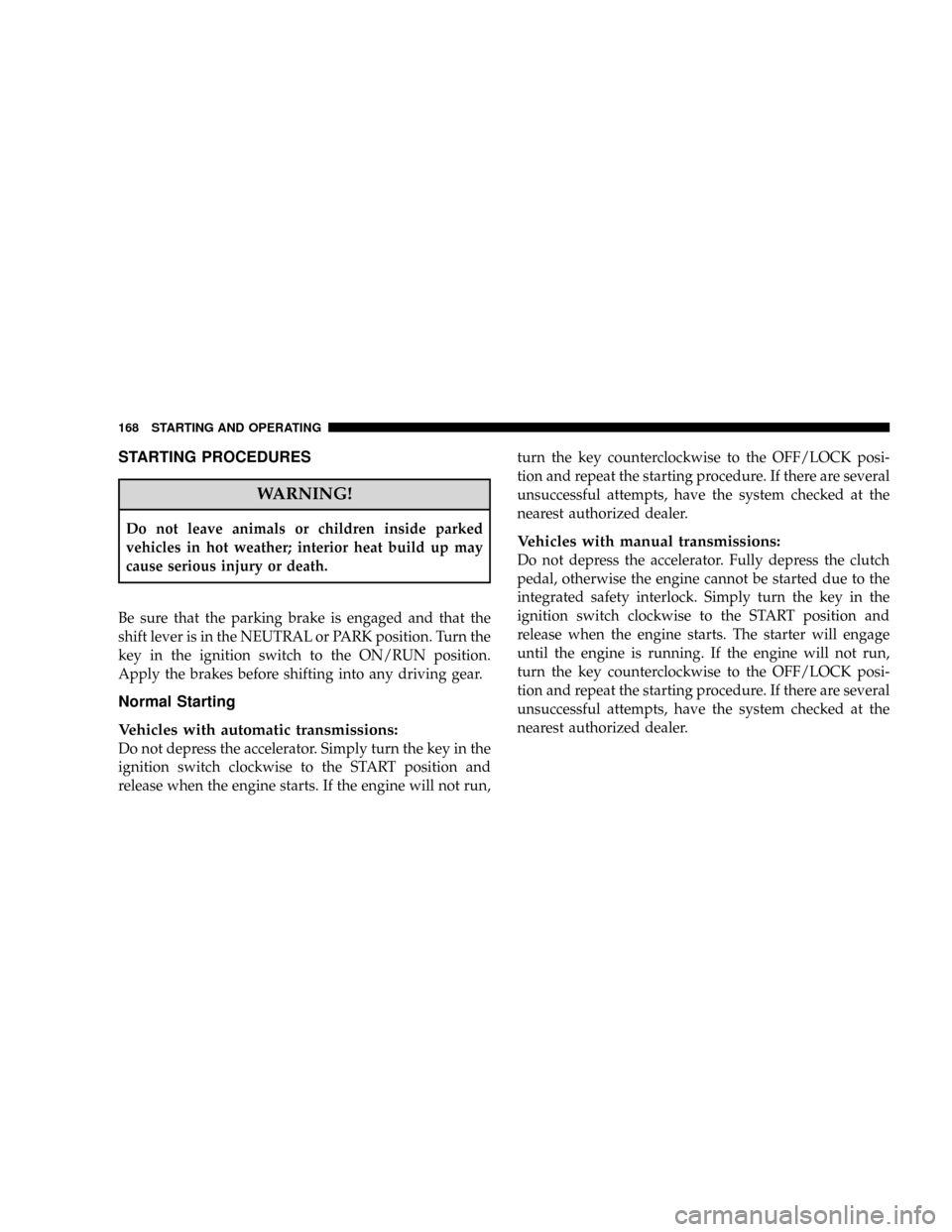
STARTING PROCEDURES
WARNING!
Do not leave animals or children inside parked
vehicles in hot weather; interior heat build up may
cause serious injury or death.
Be sure that the parking brake is engaged and that the
shift lever is in the NEUTRAL or PARK position. Turn the
key in the ignition switch to the ON/RUN position.
Apply the brakes before shifting into any driving gear.
Normal Starting
Vehicles with automatic transmissions:
Do not depress the accelerator. Simply turn the key in the
ignition switch clockwise to the START position and
release when the engine starts. If the engine will not run,turn the key counterclockwise to the OFF/LOCK posi-
tion and repeat the starting procedure. If there are several
unsuccessful attempts, have the system checked at the
nearest authorized dealer.
Vehicles with manual transmissions:
Do not depress the accelerator. Fully depress the clutch
pedal, otherwise the engine cannot be started due to the
integrated safety interlock. Simply turn the key in the
ignition switch clockwise to the START position and
release when the engine starts. The starter will engage
until the engine is running. If the engine will not run,
turn the key counterclockwise to the OFF/LOCK posi-
tion and repeat the starting procedure. If there are several
unsuccessful attempts, have the system checked at the
nearest authorized dealer.
168 STARTING AND OPERATING